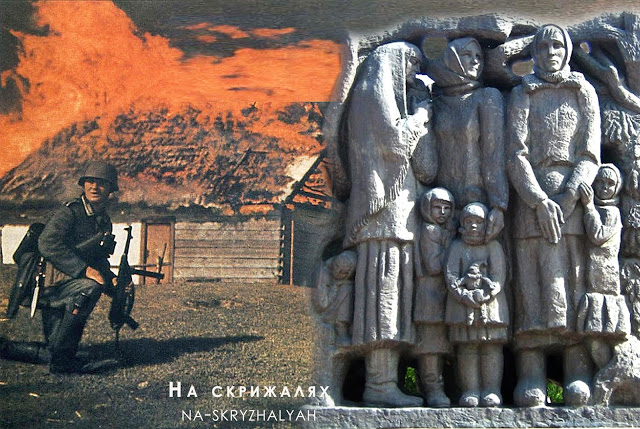In total, Nazis burnt down and destroyed 1,377 villages in Ukraine. The Koryukivka tragedy was the most massive and bloodiest not only within the territory of the Soviet Union, but throughout Europe. It happened on March 1, 1943.
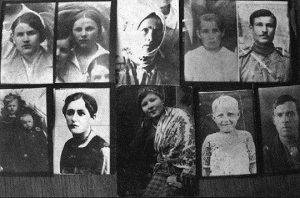
In the French village of Oradour (June 1944), Nazis murdered 642 inhabitants; in the Czech village of Lidice (June, 1943) - 320, in the Belarusian village of Khatyn (March 1943) - 149 (according to contemporary German data - 152). Europeans know about and commemorate these tragedies, but very few know about the massacres in the Ukrainian town of Koryukivka.
In 1941-1943, Chernihiv Oblast was the centre of the most active and belligerent Soviet partisan forces in Ukraine. During the German occupation, Koryukivka became the nucleus of the Soviet partisan movement in Chernihiv Oblast.
In February 1943, a Soviet partisan unit under the command of Oleksiy Fedorov, First Secretary of the Chernihiv Regional Committee of the Communist Party of Ukraine, Hero of the Soviet Union, returned from Bryansk region in Russia and set up headquarters in the thick forests surrounding Koryukivka. The partisans began collecting food from the villages and coordinating attacks against the Nazi invaders. On the night of February 27, 1943, they attacked and destroyed the German garrison in Koryukivka, where only the hospital brick building survived.
In response to the Bolshevik partisan campaign, the order to destroy Koryukivka was given by Oberstleutnant Bruno Franz Bayer (399th Main Field Kommandatur in Konotop, Sumy Oblast). The Kommandatur was subordinated to the Wehrmacht’s Heeresgruppe Sud (Army Group South).
One early morning of the following week, a detachment of German-Hungarian soldiers surrounded Koryukivka and SS guards began searching the houses. Groups of 50 to 100 people were driven into large buildings such as the church, theatre, or restaurant, and ruthlessly executed. Having massacred all the inhabitants, the soldiers set fire to different buildings: some 1,390 homes were completely destroyed and only a dozen brick walls survived the flames.

More than 7,000 residents of Koryukivka were slaughtered from March 1-2, 1943. According to several witnesses, the Nazis returned on March 9 to finalize the destruction.
Dmytro Vedeneyev, Doctor of Historical Sciences, describes the scene:
“On the morning of March 1, 1943, a squad of German soldiers and Ukrainian auxiliary police surrounded the village. On the pretext of checking documents, they drove the locals into the town restaurant, district administration, theatre, club, clinic, schools, and church yard.
The residents were divided into groups of 50-100 persons and executed in cold blood, regardless of age and gender. On March 2, the Germans set fire to all the premises containing the corpses of the victims (about 500 bodies were in the restaurant alone), but the killings in the streets continued…
The death squads continued searching the town buildings, grabbed people in the streets and from their homes, and threw them alive into the burning pyres. Vira Sylchenko, who was hiding behind a haystack, saw her mother, sister, and daughter-in-law thrown into the flames. At the same time, groups of people were mowed down by machine guns in the church courtyard, on the collective farm, in the pigsty… By the end of the day, there was almost nothing left of Koryukivka.
The survivors hid or escaped to the forests; some returned after a few days, mostly the elderly. But, the Germans also returned on March 9. Then the elderly were taken from their homes and put in a shed; the guards poured kerosene over the shed and set it on fire. In the town factory, residents were pushed into the large furnace used for firing bricks and left to burn to death..."
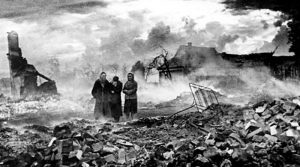
Yevhen Yukhymovych Rymar survived the massacre and lived to tell his tale:
“My little daughter was pressed closely to my chest when they opened fire in the restaurant. They had herded us in there like lambs to the slaughter ... A fascist shot me in the eye ... and I fainted. Three of my children were killed. I couldn’t even bury them ... those damned fascists burned everything…”
This punitive measure was in retaliation to an attack launched by Soviet partisans on the German garrison in the town. The partisans had planned to release several Soviet hostages from the prison, among whom were two sons of the partisan platoon commander, former head of the collective farm Feodosiy Stupak. Stupak was killed during the raid. His sons were rescued, and were subsequently sent to Moscow by plane. Stupak’s wife was executed by the Nazis.
On March 19, 1943, the Red Army entered Koryukivka, but there was no one to greet “the liberators” with smiles and flowers.
The investigation and expertise headed by the Soviet regional commission later showed that about 6,700 persons had died in the Koryukivka massacre; 5,612 bodies could not be identified.
Investigators found that death was caused by “machine gun fire, blunt force trauma, and flames - men, women and children were ruthlessly murdered. Ten of the 1,300 town buildings survived.”
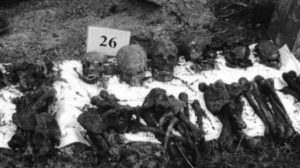
Chernihiv historians Serhiy Pavlenko and Serhiy Butko believe that the Soviet partisans could have saved some of the locals from death, but chose not to. It was to the advantage of the Politburo to highlight Nazi atrocities in Ukraine.
According to official historical data, at the beginning of 1943, Oleksiy Fedorov’s military division numbered 12 detachments with 5,500 fighters, most of whom were based near Koryukivka and in the neighbouring villages. Historians have calculated that Nazi troops sent in to “punish” the local population in the same region numbered between 300 to 500 soldiers.
“There was no order from headquarters. So, we just sat there and watched…” bragged one Soviet partisan after the war.
The orders issued by Soviet military headquarters to partisan movements in Ukraine were directed towards sabotage and destruction of enemy forces (German troops and Ukrainian nationalist units). However, there are no official documents instructing Soviet partisans to protect the civilian population. By provoking Nazis to perpetrate such massacres, the partisans were actually following Moscow’s directive, namely: “Call upon the Ukrainian people to fight against the invaders!”
For his part, Hitler believed that a guerrilla war made it possible to identify “undesirable elements” that should be destroyed. Indeed, an important reason for his decision to invade the Soviet Union in June 1941 was his desire to acquire the Lebensraum (living space) that he had been seeking for Germany since 1925. He envisaged settling Germans as a master race in western Ukraine, Belarus and Russia, while deporting most of the local inhabitants to Siberia and using the remainder as slave labour. His ideas were echoed by Heinrich Himmler, Reichsführer of the SS, whose plans included eliminating 30 million Slavs to make room for the German population.
Oleksiy Fedorov was not present at Koryukivka. He arrived from Moscow on March 5. In his memoirs, he refers briefly to the events:
“The comrades informed us about the most important military operations carried out in our absence. The most interesting and most successful was the raid on the Koryukivka garrison. Our guys didn’t forget this small town…”
Fedorov did not say a single word about the tragic death of 7,000 villagers! As if they didn’t exist!
Serhiy Butko, member of the Ukrainian Institute of National Remembrance in Chernihiv Oblast makes the following observation:
“No punitive operations instigated by the Nazis against the local population were interrupted by the Soviet partisans as it perfectly served the Bolshevik cause to have the Germans commit as many atrocities as possible. It was common knowledge that the Germans would execute up to 100 people for each German soldier killed, and these instructions were followed to the letter whatever the circumstances. So, Bolshevik partisans continued killing Germans soldiers, and didn’t even bother burying or hiding the corpses, thus provoking mass reprisals against the local population.”
This often happened in villages and small towns where the Nazis immediately executed civilians and burned them entirely to the ground. The Bolshevik policy consisted in proving to the civilian population that the atrocities perpetrated by the Nazi regime were incomparable in horror with the 1932-1933 Holodomor and the Stalinist executions and repressions of the 1930s. Yes, Nazi barbaric actions were unspeakably horrifying, but no “better or worse” than those perpetrated by the Bolshevik regime.”
After the tragic events in Koryukivka, the NKVD ordered Fedorov’s partisan detachments to deploy to Volyn Oblast where they carried out a series of sabotage actions. Caught up in frequent skirmishes with UPA units (Ukrainian Insurgent Army), Fedorov’s detachments were subsequently incorporated into the advancing Red Army.
Today, the Koryukivka tragedy is remembered in a Memorial Park, where stone tablets bear the names of the district villages that were erased from the face of the earth by the Nazi invaders. The tragedy is every year commemorated by district officials and administrations; top Ukrainian government officials have never visited Koryukivka.
During Soviet times, local residents petitioned the authorities to pay tribute to the death of their fellow countrymen, but all in vain. In the 1980s, they themselves began raising funds for a memorial, but failed to complete this mission due to the Chornobyl disaster in April 1986.
At the end of 2010, the Chernihiv Regional State Administration published 500 copies of a collection of documents and memoirs of eyewitnesses: “Koryukivka, 1943: Crime against Humanity”.
Ukrainian historians have recorded that in 1941-1943 the Nazis burned, hung, shot, and tortured to death about 127,000 civilians just in Chernihiv Oblast (during the Second World War, the Polish Army lost a total of 123,000 fighters).
4,800 souls perished in the village of Kozary, about 800 in Vedyltsi, 682 in Sribne. The Institute of Ukrainian History of the National Academy of Sciences of Ukraine has published a book recounting the atrocities committed by the German regime in different regions of the former Ukrainian SSR.
The Memorial Architectural and Sculptural Complex in Khatyn, Belarus was built in 1969 in a 50-hectare park. It is displayed as a symbolic “cemetery of villages”. There are 185 tombstones that mark the 185 Belarusian villages destroyed by the Nazis. The 186th is Khatyn. There is also a “Tree of Life” whose branches bear the names of 433 new villages that were created after the war.
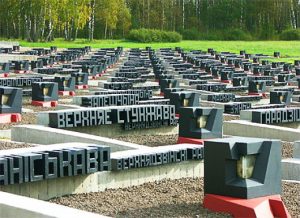
Why did the Communist regime choose to remember Khatyn and forget Koryukivka?
Professor Oleksandr Lysenko, Doctor of Historical Sciences, provides the following explanation:
“The Politburo didn’t always choose to highlight the most spectacular or memorable event as a symbol of German atrocities. It wasn’t always the largest number of victims that counted most… Frankly, it’s difficult to understand the ideas that motivated Soviet ideologists. For political reasons, the Politburo would acknowledge the sacrifices made of one nation or a certain ethnic group. Yes, the Belarusian people suffered greatly during the Second World War, so Moscow decided that Khatyn was worthy of commemoration and Koryukivka was not.”
Lysenko says that Soviet authorities did not want to glorify events that were not entirely clear because inquisitive ethnographers could learn about the reverse side of the medal:
“German headquarters reacted strongly to special operations organized by Bolshevik partisans, some of which could be justified, but often such actions were carried out to provoke the Nazi invaders and show the local population how cruel the Germans really were.”
In March 2005, Ambassador Extraordinary and Plenipotentiary of the Federal Republic of Germany Dietmar Studemann and his wife Karin Arno Kirchoff visited Koryukivka to commemorate the victims.
During the memorial service, the Ambassador bowed his head and said:
“We, Germans, are well aware of the crimes that fascists committed in your country. The grief and destruction that they brought eventually destroyed them. After the death of Koryukivka, fascist Germany also perished. Many years have gone by. Germany and Koryukivka have survived and live again, and Ukraine has become independent. The peoples of our countries have joined hands together over the graves of the dead, although our fault is immeasurable. But, our friendship has won, and it gives all of us hope that war will not be repeated again, that we will never again see the face of fascism...”
Together with the Vinnytsia massacre, Baby Yar, the NKVD prisoner massacres in Western Ukraine and other Nazi and Bolshevik/Communist atrocities perpetrated throughout the country, the Koryukivka tragedy must be remembered and commemorated with reverence, respect and solemnity.
Video in Ukrainian/Russian (26:30)
[embedyt] http://www.youtube.com/watch?v=2eDjP5FfpPQ[/embedyt]

